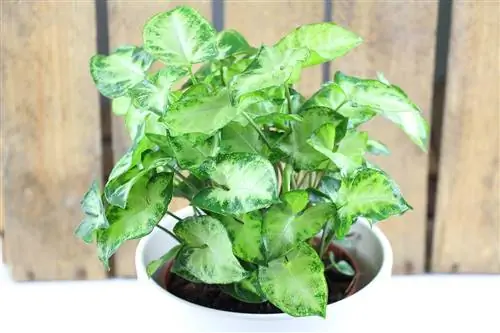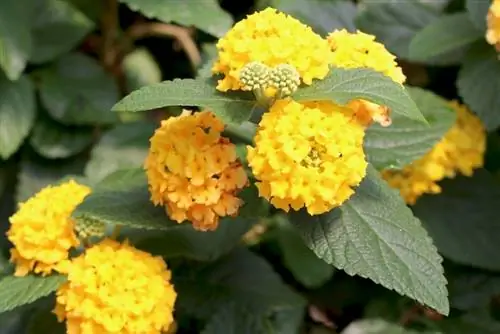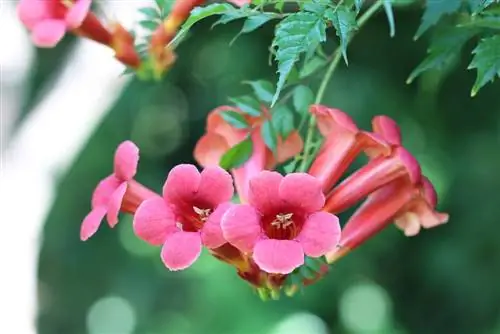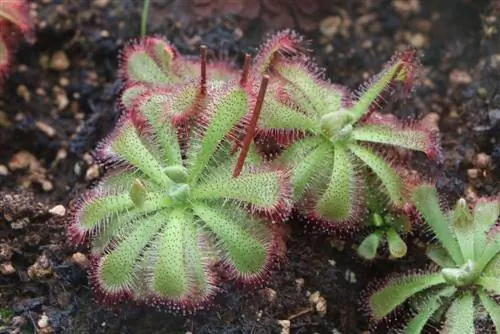- Author admin [email protected].
- Public 2023-12-17 03:39.
- Last modified 2025-01-24 12:45.
Decorative, easy to care for and always fascinating thanks to the changing flower colors - the lantana is delighting more and more garden owners. The lushly flowering plant, which is native to the southern part of North America and Central America, can be grown and propagated with little effort. Anyone who offers their lantana optimal growing conditions will be able to look forward to an abundance of flowers from May to October.
Location
So that the lantana thrives well and produces many flowers, choosing the right location is important. The following aspects must be taken into account:
- A sunny area in the garden is optimal
- Cultivation is possible even in partial shade if there is sufficient brightness
- Rain protection is recommended
Note:
If you grow your lantana in partial shade, you should always keep an eye on the sun's rays; the less bright the plant is, the slower it will bloom.
The lantana can generally be planted in the outdoor bed; However, the plant would then have to be dug up again before the cold season sets in, as wintering must under no circumstances take place outdoors. It has therefore proven to be useful to plant in a pot, as this makes transport to the winter quarters easier.
Floor
In addition to the location, the soil conditions are also important in stimulating the plant's ability to bloom. The substrate used should have the following properties:
- rich in nutrients
- pH value: acidic to neutral
- loose features
- good permeability
To avoid waterlogging, the lantana should be planted in a clay pot with a drainage hole. For optimal drainage, place a layer of expanded clay or a piece of clay on the bottom of the pot.
Plant neighbors
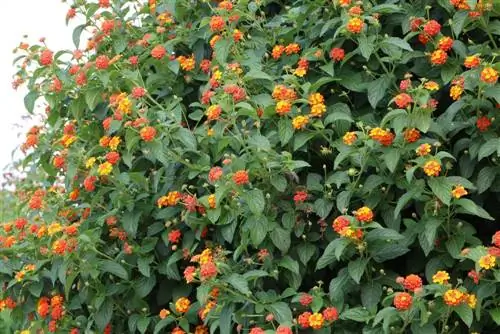
Basically, numerous different plants that have similar cultivation conditions can be combined with the lantana. Nevertheless, it is also worth taking the decorative aspects into account when planting. Lantana usually initially produces yellow or orange flowers that turn red or purple over time; That's why a combination with flowers, which look more subtle, is a good idea. It is recommended to underplant with white alyssum or small, yellow daisies.
Pouring
In order to promote flower production during the warm season, regular watering of the lantana is necessary; However, it is important to pay attention to correct watering behavior:
- uniform supply of water
- Keep water portions as small as possible
- Rainwater is best (sensitive to limescale!)
- Stale water can also be used
- Potting soil should always remain evenly moist
- Waterlogging must be avoided at all costs
Tip:
How often the lantana is watered also depends on the location; Significantly more water evaporates in full sun than in partial shade. It is important that the plant is supplied with moisture as soon as the substrate feels dry.
Fertilize
Since the lantana produces numerous colorful flowers, the plant needs a lot of nutrients. These should be issued as soon as the plant is moved outdoors after the cold season and the leaves have formed after pruning. However, at the beginning of the growing season, it is sufficient to fertilize once a month. Only when the first blossoms appear can the dose be increased; then the lantana needs the vital nutrients every two weeks.
With regard to the optimal fertilizer product and targeted application, the following aspects are also important:
- A commercially available liquid fertilizer is generally suitable
- The dosage of mineral fertilizer must not be exceeded
- Natural fertilizer can also be used
- Fertilization continues until late summer
- From September the fertilizer-free phases will be longer again
Repotting
Care also includes regular checking of the pot size; To do this, the drainage hole of the plant container is inspected; If roots are already growing out of this opening, the lantana is ready to be transplanted into a larger pot. However, the successor pot should only be one size larger; otherwise there is a risk that more roots will be formed at the expense of the leaf mass. When repotting, a lot of sensitivity is required: under no circumstances should the delicate root ends be injured!
Cut
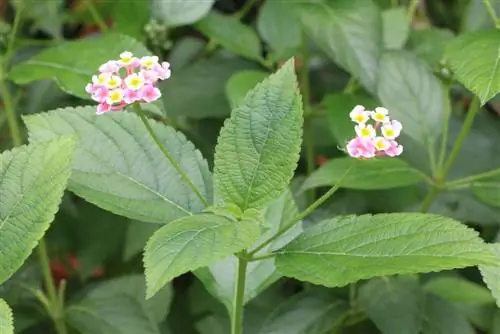
At the beginning of budding, the lantana receives a care cut in which the shoots are shortened significantly; The plant only produces lush flower growth on young shoots, while older shoots only develop a few flowers.
When cutting, the hobby gardener should pay attention to certain points:
- Shoots can be halved or even shortened to a third
- The extent of pruning depends on the season and vigor
- Pruning is possible up to the maximum hand width
- Gloves must be worn when cutting due to the toxicity of the plant
- Disposal must be done in such a way that skin contact is no longer possible
However, targeted pruning can also be used to extend the flowering season; If the hobby gardener removes all withered flowers promptly, the lantana's ability to bloom can be extended until late autumn.
Wintering
Caring for the lantana involves, above all, very careful overwintering after a successful flowering season. The plant, which is native to warm and sunny areas, is already causing serious problems when the temperature drops in the fall. Therefore, if cold nights are predicted in autumn, the plant must definitely be brought indoors. At the latest when the temperatures are below zero, the move to winter quarters is finally indicated. Lantana spends the cold season under the following conditions:
- at temperatures between 5 and 10 degrees Celsius
- in a bright location
- We only water sparingly
- only drying out needs to be avoided
- There is no fertilization
The best way to overwinter the lantana is in a cold house; Alternatively, another bright room is also suitable, for example a winter garden or a cellar with a window. It is important that the plant is never exposed to frost.
Note:
During the cold season, the lantana is set to hibernate. From the first early spring - usually mid-February - the lantana should be given warmer temporary quarters so that the metabolism can be gradually increased.
Propagate
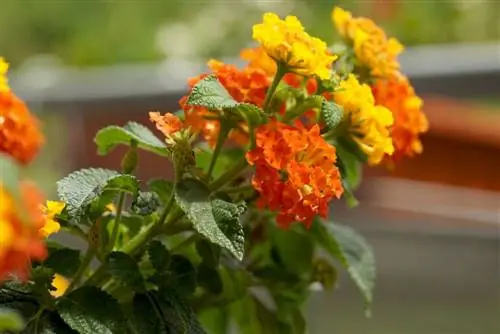
Radiantes are very easy to propagate and spread very quickly. For targeted propagation, cuttings that the hobby gardener receives from the spring cut are usually used. When cutting a cutting, the following aspects should be taken into account:
- Annual shoots serve as starting material
- The cut is made on a he althy piece of the end of the shoot
- The selected cutting should already be slightly woody
- The optimal cutting size is 10cm
- The lower end is shortened so that it ends just below the pair of leaves
- The two lower leaves, shoot tips and flower heads must be removed
The cutting obtained in this way ideally has a pair of buds on the top and bottom; In addition, there should be four to six leaves.
For cultivation, the cutting is placed two centimeters below the first pair of leaves in a pot that is filled with growing soil. If the stems have a very soft consistency, it is important to poke a plant hole first. This works best with a pricking stick. After planting the shoot, press the soil carefully with your fingers.
Afterwards it is important to keep the cuttings well moist; This works best if the pots are covered with foil. The first roots will form after around two weeks.
As an alternative, rooting the shoots in a glass of water also works; For this purpose, it is best to use soft rainwater, which is changed every few days. The best results are achieved when an opaque container is used.
Note:
If you root the shoots using the water glass method, you should know that the failure rate is higher!
As an alternative to propagation via cuttings, lantana can also be propagated through targeted sowing. However, anyone who obtains seeds from their own hybrids must be prepared for the fact that the plants obtained from them will not be of the same variety; For example, it is possible that other color compositions can be created.
Pests
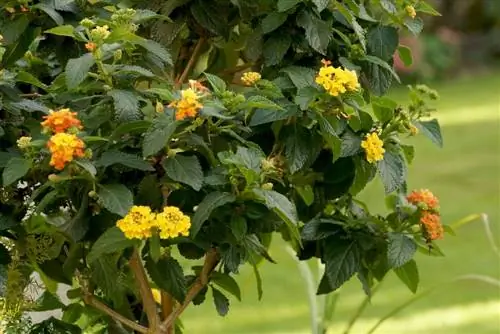
Lanate lantana is mainly attacked by pests in the cold season; The winter quarters offer conditions that are unusual for plants native to warm areas. The dry air in particular during the winter months can lead to aphid infestations. If the plant is affected, it shows the following symptoms:
- small, green lice on the undersides of the leaves
- white lice eggs on the leaves
- sticky film on the leaves (honeydew excretion)
To prevent aphid infestation, various pest sticks can be inserted into the potting soil. In some cases, a clove of garlic or a lavender plant in the immediate vicinity also helps to repel the lice. If the plant is already showing symptoms, neem preparations or soapy water can also help.
One of the well-known pests is the whitefly, which is best controlled with parasitic wasps. In the event of an infestation, it is important to act quickly so that the plant is not permanently damaged; Especially during the cold season it can be very difficult for the lantana to regenerate.
If you pay attention to optimal conditions, especially in winter, and care for the lantana carefully, you will be able to enjoy many colorful flowers again the following year.


